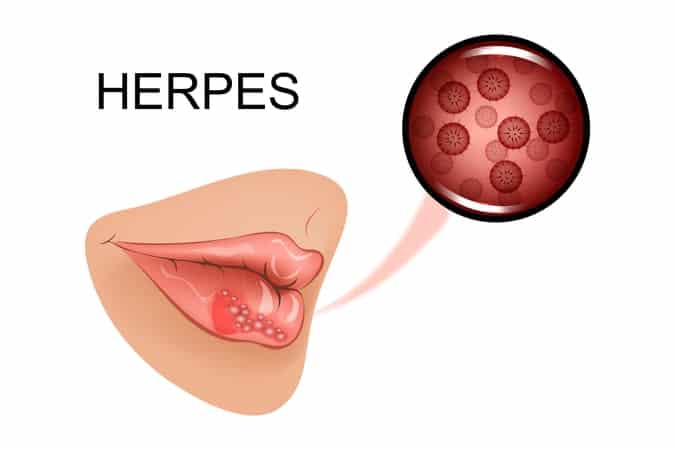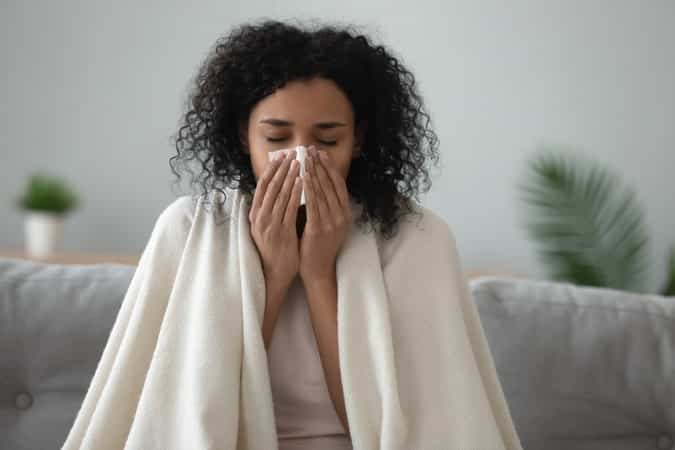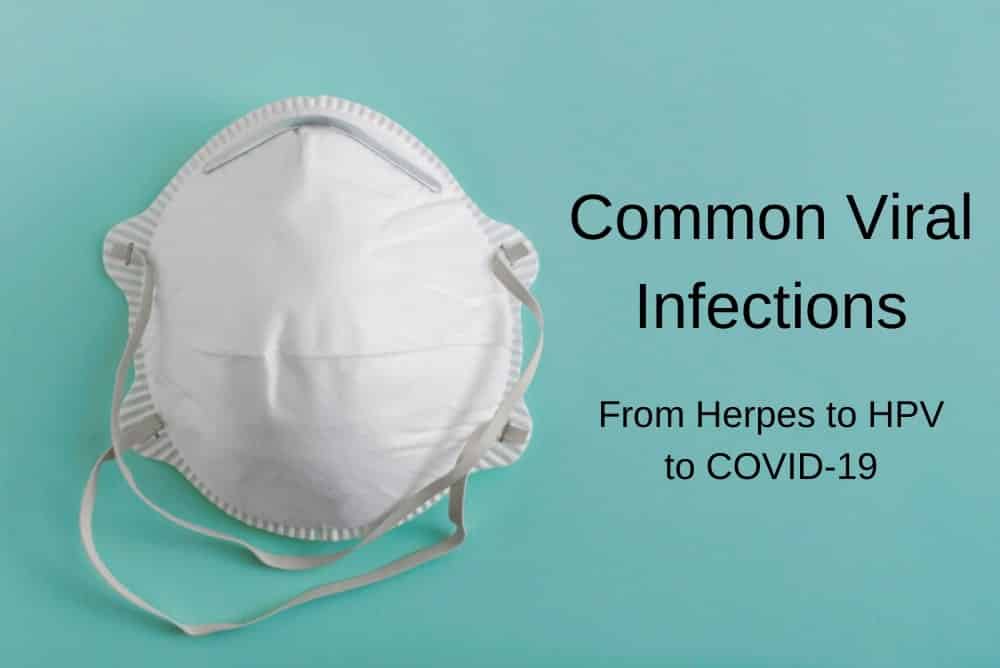Viruses are not living organisms but small proteins of DNA or RNA. Viruses enter a host through contact with ocular, mucosal, or nasal cells, integrating their genetic material into cells. Each virus subtype has a unique way of gaining access to a host and proliferating its genes into human cells.
Some viruses act quickly and cause acute symptoms, like the cold and flu. Other viruses hide within cell bodies and slowly replicate over time, causing more serious diseases like cancers.
How the body reacts to a virus is also unique. The severity depends upon the state of the individuals’ immune system, their overall health, and whether the host has seen the virus before.
Here we outline a number of common viruses, their prevalence, and how we can naturally reduce their occurrence and impact on the human body through lifestyle factors.
Herpes
There are three subfamilies of herpes viruses; herpes simplex virus-1 HSV-1, herpes simplex virus-2 HSV-2, and varicella-zoster virus VZV. Together, the herpes viruses infect about 90% of the population worldwide.
HSV-1 is the common cause of cold sores and can be transmitted through oral, mucosal contact, or through maternal transmission.
HSV-2 is typically associated with genital herpes, transmitted through sexual contact.

VZV causes chicken pox, most commonly in children and can re-activate later in life as a painful neurological skin condition, shingles.
While the herpesviruses are not deadly, they are unique in that they can reactivate after initial infection, causing recurrent symptoms.
Reactivation may be caused by a weakened immune system, physiological processes, poor nutrition, disease, or stress, making the manifestation of symptoms highly dependent on the strength of the host’s immune system.
HPV
The human papilloma virus contains a group of over 100 viral strains that infect the skin and mucous membranes. Up to 80 percent of people will contract a strain of HPV in their lifetime. HPV is often sexually transmitted but can easily be transferred through skin-to-skin contact.
The HPV virus is a double-stranded DNA, non-enveloped virus. Once the virus enters the skin it attaches to squamous keratinocytes where it replicates, proliferates and then moves to the next cell.
In most cases, the viral strains are self-limiting and will be cleared by a healthy immune system naturally over time. Some high-risk strains of HPV can cause cervical cancer, oral cancer, or cancer of the anus and vulva. Persistent infections occur when the virus is able to further invade local tissues and can eventually grow into a malignancy.
Rhinovirus
The common cold is typically caused by the rhinovirus.
A member of the picronavirus family, the rhinovirus is a small, nonenveloped RNA virus with over 100 different serotypes.
The rhinovirus is more prevalent in the fall and spring, causing roughly one-third to one half of common colds annually.

The rhinovirus is transmitted through aerosol person-to-person contact. The virus attaches itself to the respiratory epithelium and spreads locally, generally causing mild acute upper respiratory symptoms that go away on their own over a short period of time.
In some cases, the rhinovirus may lead to asthma or chronic obstructive pulmonary disease or infiltrate the lower respiratory tract.
Influenza
Is the most common cause of acute respiratory illnesses. Influenza usually occurs in annual outbreaks in the winter, affecting people of all ages but the greatest prevalence is in school-age children.
There are a number of types of influenza viruses: A, B, and C. Influenza A and B are mostly seasonal and occur during the winter months. Influenza C is more severe and can cause mild respiratory disease.
The influenza viruses contain two surface proteins, hemagglutinin (H) and neuraminidase (N), that classify the virus strain. New variations in these surface proteins can occur overtime, leading to new viral strains that may be more infectious to humans.
Influenza infections typically incubate for 1-4 days, causing symptoms of chills and fever, cough, body aches and pains. Influenza may also cause respiratory symptoms like sore throat and a productive cough.
Coronaviruses
Coronaviruses are a large family of viruses that cause a range of illnesses in humans from 10-20 percent of common colds to severe acute respiratory syndrome (SARS).
Over the past two decades, three coronaviruses not previously identified in humans, have spread from animal to human; SARS-CoV, MERS-CoV, and most recently, COVID-19.
New viruses pose additional threats to the human immune system, having no existing memory to initiate a quick, strong defense. In older and immune-compromised individuals, the virus can lead to SARS and increased mortality.
The novel COVID-19 specifically uses the ACE II receptors found on the lungs, heart, and digestive tract to get into cells and replicate in the body.

The number of ACE II receptors expressed in the body is correlated with individuals with higher levels of stress and tissue damage, specifically in people who are elderly, or who have diabetes, or higher levels of systemic inflammation.
RSV
Respiratory syncytial virus (RSV) is the leading cause of lower respiratory tract infections, predominantly in children.
RSV includes two subtypes, A and B. Subtype B includes asymptomatic strains or mild symptoms of common cold.
More severe outbreaks, often caused by subtype A, can reach the lower respiratory tract and may lead to pneumonia and bronchiolitis.
RSV is spread through person-to-person contact, through nasal secretions or contamination of hands or objects introduced to the secretions. Outbreaks of RSV occur annually, typically lasting for up to 5 months of the year.
Four Lifestyle Therapies
The way the body fights all viruses depends on the health of the immune system. Four core lifestyle factors play a role in preparing the body for responding to infection and fighting off disease:
1. Nutrition and Supplementation
The gut is home to around 80% of the immune system. Consuming fruit and vegetable-rich diet, limiting sugar and refined carbohydrate intake has been found to have a positive effect on the overall function of the immune system.
2. Psychological Stress
Prolonged stress has been found to create an imbalance in the ability of the body to fight incoming infection, by over-activating areas of the immune system that exacerbate chronic illness. Engaging in daily stress management practices like meditation, exercise, and socializing can have a positive effect in improving the body’s overall resiliency.
3. Sleep
Getting adequate rest, seven to eight hours of quality sleep per night, allows the immune system time to revitalize, balance hormones and it initiates cellular repair. Setting a regular bedtime, limiting caffeine intake in the afternoon, and eating a nutrient-dense diet are all ways we can improve our sleep quality.
4. Exercise and Movement
From improved circulation to naturally increasing the bodies white blood cell and antibody count, staying active has a range of benefits in helping support the immune system and defense against disease. We recommend taking daily walks and engaging in bi-weekly strength training and aerobic activity.
Anti-Viral Supplementation
A number of anti-viral herbs and nutritional supplements have been reviewed for their effectiveness in reducing viral infections and disease.
Taking a therapeutic dose of vitamin C, along with vitamin A (or mixed carotenoids) and vitamin D have been widely researched for their ability to prevent and reduce the effects of the common cold and other viral infections.
Anti-viral herbs like astragalus, licorice root and elderberry have also been found to have positive immunostimulatory effects.
Why not check out our picks for top ten antiviral herbs?
AHCC® and Viral Infections
Medicinal mushrooms like reishi, contain polysaccharides which have been found to improve immune function in response to several different viruses.
A medicinal mushroom based product called AHCC® has been researched for its ability to stimulate the immune system in humans, having a protective effect against a wide-range of viruses including, influenza, HPV, and herpes.
The actions of AHCC® in protecting against a wide range of viral infections suggest that it could also support the immune system against the novel COVID-19.





